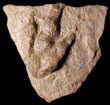General
Information
Significance to Earth Sciences
Although a trace fossil is not a preservation
of the specimen itself, the trace fossil may be the only evidence for a
researcher to utilize in the field. Conditions do arise in which
hard parts are not preserved due to overlying factors within the depositional
and preservational environment. In some cases preservation of body
fossils may not be possible yet the trace fossils are well preserved.
Some instances and benefits may include:
-
shallow high energy environments, shallow marine sandstones, and deep
marine shales normally too harsh an environment for body fossil preservation
-
no body or body parts to be transported, therefore excellent for analysis
of primary sedimentary environments
-
processes of diagenesis, clastic sedimentary units which can heighten
the relief of the trace fossil
-
trace fossils occur over long periods of time due to the fact that they
are made by ãsimilar organisms with similar behaviorsä, a good indicator
for broad periods of environmental change
-
trace fossils are more abundant than the organism's body fossil, an
organism can repeatedly produce them in one life span
These general trace fossils can be categorized and shown to record:
-
biogenic sedimentary structures; footprints, trackways, and burrows
are examples of structures formed in unconsolidated material
-
bioerosion or bioturbation; borings are examples of sediment being altered
by the actions of the organism
-
paleodiets of extinct species; coprolites not only tell us about their
diets but they also; provide additional information so that we can
reconstruct ecosystem relationships of fossil plants and animals
-
procreative behavior; eggs and nests display proof that certain species
reproduced sexually and constructed structures for the development and
shelter of their offspring


